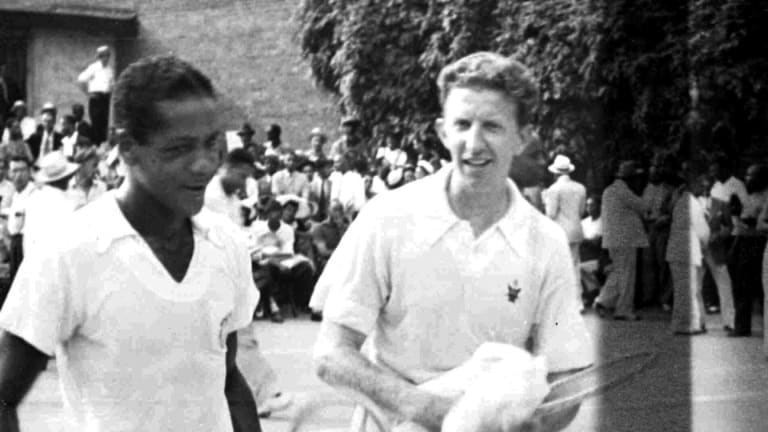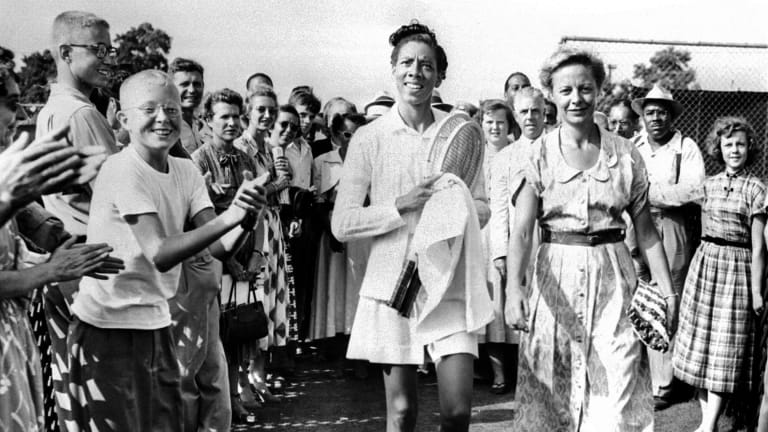The Pioneer: McDaniel breaks tennis' color barrier—for a day—vs. Budge
By Steve Tignor Jul 29, 2020Madrid, Spain
Elena Rybakina is a sore winner (this is a good thing)
By Peter Bodo Apr 23, 2024Zendaya, Josh O'Connor and Mike Faist on the steamy love triangle of 'Challengers'
By Associated Press Apr 23, 2024Madrid, Spain
Tatjana Maria will follow daughter Charlotte’s first tournament on live scores from Madrid
By David Kane Apr 23, 2024Madrid, Spain
“I hope to make it”: Carlos Alcaraz eyes Madrid three-peat for 21st birthday gift
By TENNIS.com Apr 23, 2024Betting Central
Line Calls, presented by FanDuel Sportsbook: WTA Mutua Madrid Open Betting Preview
By Baseline Staff Apr 23, 2024Lifestyle
Without a driver's license, what will Elena Rybakina do with the Stuttgart Porsche?
By Baseline Staff Apr 23, 2024Pop Culture
How does Taylor feel about Taylor? Fritz speaks on his appreciation for Swift
By Baseline Staff Apr 23, 2024Pop Culture
Novak Djokovic named Laureus World Sportsman of the Year for a fifth time
By Baseline Staff Apr 22, 2024Pop Culture
Josh O’Connor channels Nick Kyrgios in ‘Challengers’ movie with co-star Zendaya
By David Kane Apr 22, 2024The Pioneer: McDaniel breaks tennis' color barrier—for a day—vs. Budge
Eighty years ago in Harlem, Jimmie McDaniel and Don Budge played a match at the Cosmopolitan Club. But while McDaniel helped open doors for the sport, he found they were still closed to him.
Published Jul 29, 2020
Advertising
The tone of those words may seem strangely contradictory. On the one hand, the New York newspaper was declaring that history had been made: For the first time since tennis arrived in the United States six decades earlier, a white player and a Black player had met in a top-level match. On the other hand, the author, Ed Hughes, admitted that the sport’s color line might only “temporarily” vanish. As with so many other moments of racial progress in the U.S., both of these viewpoints—the optimistic and the skeptical—would prove to be correct.
The match that had been played the previous day, between Don Budge and Jimmie McDaniel at the Cosmopolitan Club in Harlem, was an earth-shaking event for sports in the United States, a fact that wasn’t lost on the local Black community. Two-thousand people crammed the club’s stands to capacity. Others leaned out the windows and crowded onto the fire escapes that overlooked the court. Those who didn’t have a view could hear the score called on a public-address system. Prominent tennis writer Al Laney was on hand for the occasion, and he praised Budge for “performing an important service for the good of the game.”
“This was really a major event,” says Art Carrington, a pro in the 1960s and ’70s who serves on the board of the Black Tennis Hall of Fame. “You have to remember, it was seven years before Jackie Robinson, and 10 years before Althea [Gibson] played at Forest Hills. Outside of boxing, there weren’t many places where Blacks and whites competed.”
Equally remarkable is where the breakthrough contest took place. In the cases of Robinson, Gibson and Kenny Washington, who became the first Black player to sign an NFL contract in 1946, an African-American athlete crossed over to a white league. By coming to Harlem, Budge was crossing over to a Black league, at least for a day. The Cosmopolitan Club was the headquarters of the American Tennis Association (ATA)— home to the nation’s Black players—and the Budge-McDaniel exhibition was held in conjunction with an ATA tournament. That organization, unlike most U.S. sports leagues at the time, was open to all races.

The Pioneer: McDaniel breaks tennis' color barrier—for a day—vs. Budge
Advertising
Budge’s bonafides are the stuff of legend—most notably becoming the first player to win the Grand Slam, in 1938. But McDaniel won 38 of the 43 tournaments he entered between 1939 and 1941. (Xavier University of Louisiana Athletics)
How did Budge, from San Francisco, and McDaniel, from Los Angeles, end up on a court in New York? After winning the calendar-year Grand Slam in 1938, Budge turned pro. His sponsor, Wilson Sporting Goods, came up with an idea that was sure to generate publicity: have Budge try to complete his global conquest of the game against the country’s best African-American player.
That player was clearly McDaniel, who was at the peak of his powers. A tall and graceful multi-sport athlete with a strong left-handed serve, he would win the ATA Nationals four times. Between 1939 and 1941, McDaniel entered 43 tournaments and won 38 of them. At that point, the ATA was no small organization. According to Sundiata Djata, author of Blacks at the Net, there were 150 African-American tennis clubs in the U.S. in 1939, and 28,000 players competing on their courts.
“Wilson Sporting Goods was very proactive to get a white player to go into the Black world,” Carrington says. “They were completely separated and segregated then.” The presence of Budge, the world’s best white player, generated an electric atmosphere at the Cosmopolitan Club. When McDaniel fired off a pair of early winners and won the opening game, the excitement in the crowd rose. Did he have a chance? Budge quickly gave them his answer by reeling off the next six games and winning 6–1, 6–2. A nervous McDaniel double faulted 13 times, and was defenseless against Budge’s famed one-handed backhand. Having grown up on hard courts, he was also a fish out of water on the clay at the Cosmopolitan Club.
“I remember getting thoroughly waxed,” McDaniel told journalist Barry Meadow of World Tennis four decades later. “[Budge] hit a backhand so hard it dug a hole in the clay. I turned around and said to my coach, ‘What do I do with that?’”
The truth was, nobody, white or Black, could do much with Budge in those days. “A lot has been said about how poorly McDaniel played. Well, I didn’t get that impression at all,” remembered Des Margetson, who was a ball boy that afternoon, in the ATA documentary Breaking the Barrier. “It was that Budge sustained his depth so well, and got his first serve in almost every time.”
Despite his routine win, Budge saw McDaniel’s potential.
“All he needs is a little more practice against men of our caliber,” Budge said, “and I’m convinced that he will have a good chance of being one of the best players in America.”
That chance would never come for McDaniel. When the U.S. entered World War II the following year, he went to work at a Lockheed Martin aircraft factory in Los Angeles. His match with Budge would fade from people’s memories, and as the country’s attention shifted to the conflict overseas, the progress that it represented would also be halted. It would be 10 years before Gibson took the next step by integrating the U.S. Nationals at Forest Hills. The color line in tennis had been crossed on that summer day in Harlem, but it hadn’t been erased. Budge, of course, would never be forgotten. He’s one of only two men to win a calendar-year Grand Slam, and his backhand is still considered by many to be the best in history. He’s also remembered for winning what was long considered the best match in history, over Baron Gottfried von Cramm in a U.S.-Germany Davis Cup tie held at Wimbledon in 1937.

The Pioneer: McDaniel breaks tennis' color barrier—for a day—vs. Budge
Advertising
The Cosmopolitan Tennis Club in Harlem once served as the organization’s headquarters and promoted the sport to a burgeoning black middle class. (Bob Davis/Black Tennis Hall of Fame)
And what about McDaniel? As with so many of his fellow ATA champions from the Jim Crow era, his career has largely been left out of the sport’s official history. There are few references to him in its encyclopedias, and even Budge failed to mention his historic match with McDaniel in his 1969 autobiography.
“It has been 40 years since Jimmie McDaniel was at the peak of his game,” Meadow wrote in World Tennis in 1979. “Time has passed him by. No famous camps bear his name. No dinners have been held in his honor. No one much remembers anymore.”
Yet if tennis had left McDaniel behind, he could never do the same to the sport he loved. He had been drawn it from an early age, and had ignored anyone who tried to pull him away from it.
McDaniel’s father, Willis, was a former Negro League baseball player who worked as a railroad porter in Los Angeles; his mother, Ruby, was a domestic worker. Tennis wasn’t big in his neighborhood, but McDaniel spent hours practicing on a backboard and a dirt court at his grammar school, and picking up whatever matches he could in Exposition Park. At home, he spent more hours in front of a mirror, mimicking the strokes of the good players he saw.
Yet he never took a lesson or had a coach, and his older brother, Al, warned him that there was little future in the sport for him. After leading Manual Arts High School to a league title his senior year, and losing an 13–11 second set to a young Bobby Riggs, McDaniel was recruited by Xavier University of Louisiana—to run track, not to play tennis.
But the courts kept calling him back, and McDaniel soon quit track to join Xavier’s tennis team. Banned from the NCAA Championships, he dominated a Black-college circuit that included schools like Tuskegee, Hampton and Prairie View.
By 1939, McDaniel had won his first ATA title. His final-round victory over Reginald Weir caught the attention of the white media.
“McDaniel and Weir put on the best tennis performance since Negroes first learned to play the game in the 1890s,” a reporter for Time enthused. Most people watching McDaniel “thought he was good enough to represent the U.S. on the Davis Cup team.”

The Pioneer: McDaniel breaks tennis' color barrier—for a day—vs. Budge
© AFP via Getty Images
Advertising
Ten years after McDaniel’s match with Budge, Gibson—in what is commonly seen as tennis’ barrier-breaking moment—became the first African-American to compete in a Grand Slam event. (Getty Images)
In reality, there was no path upward for McDaniel in tennis. He couldn’t play for his country, or join one of the barnstorming pro tours of the 1940s. He couldn’t even enter most of the tournaments in his hometown. The times when he was allowed to play, he would find himself wondering, in the back of his mind,
“When are they going to come get me?” So McDaniel stayed at Lockheed Martin, married, and had five children. In the late 1950s, he tried to give up tennis for golf, but after looking at himself in a mirror and seeing a “big, fat guy,” he returned to the courts once more. By then he was allowed to walk into white clubs and enter USTA events, and he earned a Top 20 national ranking in the 60-and-overs.
According to Carrington, not everyone had forgotten McDaniel.
“He was a legendary figure in Black tennis,” Carrington says. “And he was a charismatic person. Tall, with a nice left-handed serve, and he had great stories. But most people didn’t know much more than that.”
By all accounts, McDaniel was a proud person who never pushed his legacy or promoted himself. Some who knew him only found out about his tennis accomplishments through other people. But McDaniel admitted to Meadow that some recognition of his record, and his place in tennis history, would have been welcome.
The same is true for the match he played against Budge, Carrington believes. To him, echoes of what happened at the Cosmopolitan Club in 1940 can be heard in the protests that united Black and white America in the spring of 2020. “There were whites going up to Harlem then, to the Savoy Ballroom, but it’s hard to realize the magnitude of a white tennis player like Budge going there,” Carrington says. “But you had to have white people involved to make changes happen.”
The changes that eventually happened in tennis and the U.S. came too late to help McDaniel. And as we’re still reminded today, the color line in this country is never going to magically disappear. But on the 80th anniversary of McDaniel’s match against Budge, we can take a moment to remember how both men made it just a little harder to see.

The Pioneer: McDaniel breaks tennis' color barrier—for a day—vs. Budge
Advertising
Monday, July 27: Sofia Kenin | Monday, July 27: Elena Rybakina | Monday, July 27: Alex de Minaur, Dayana Yastremska, Casper Ruud | Tuesday, July 28: Stefanos Tsitsipas | Tuesday, July 28: Thiago Seyboth Wild | Wednesday, July 29: Amanda Anisimova | Wednesday, July 29: Brandon Nakashima